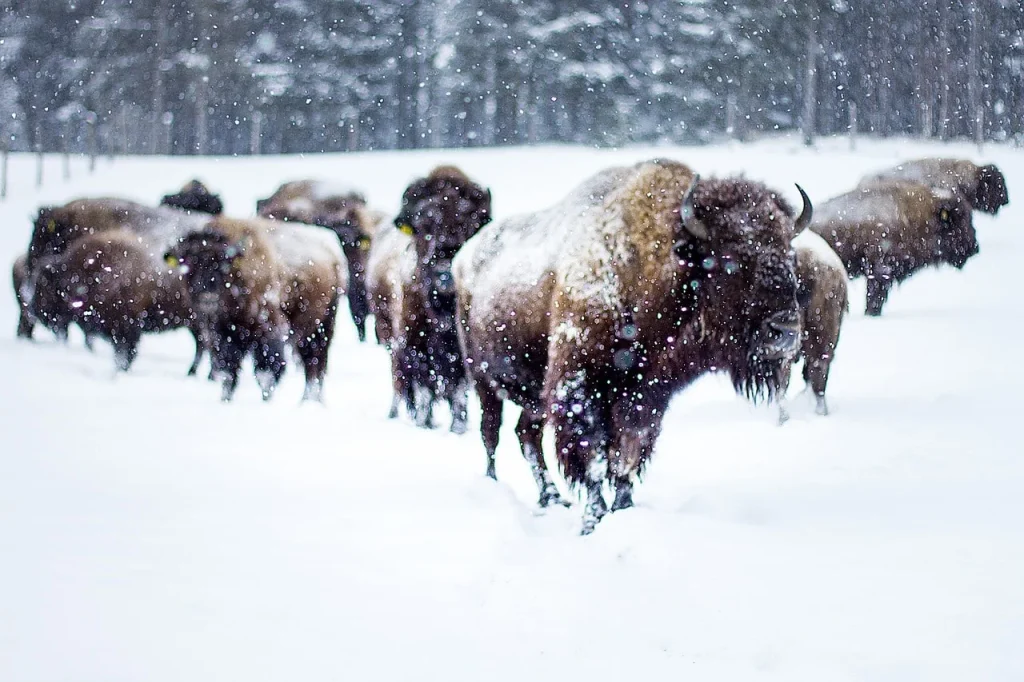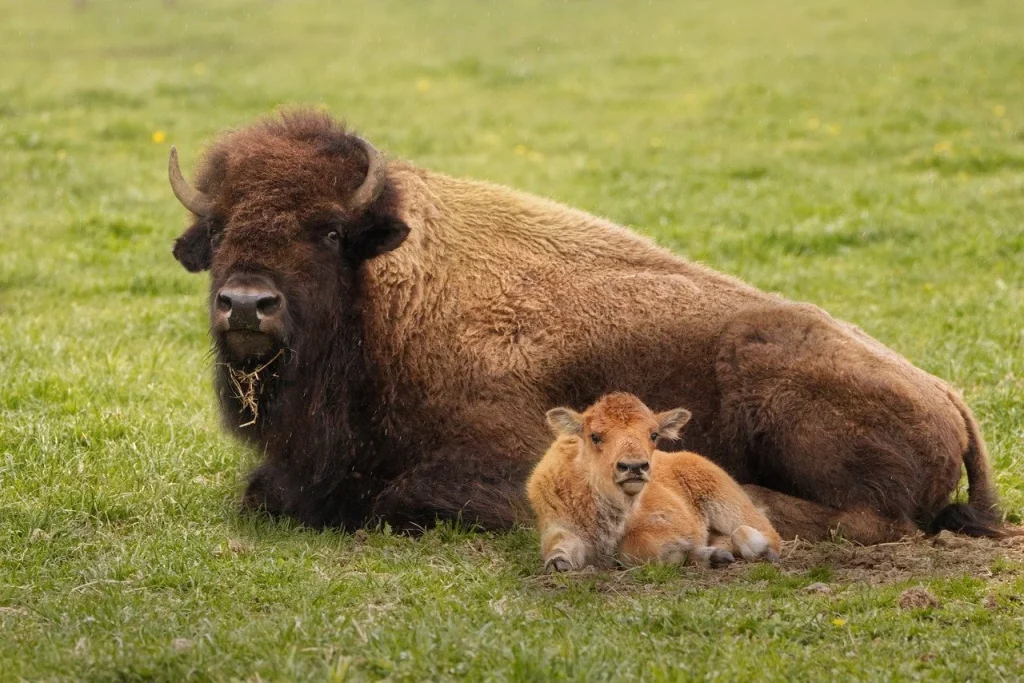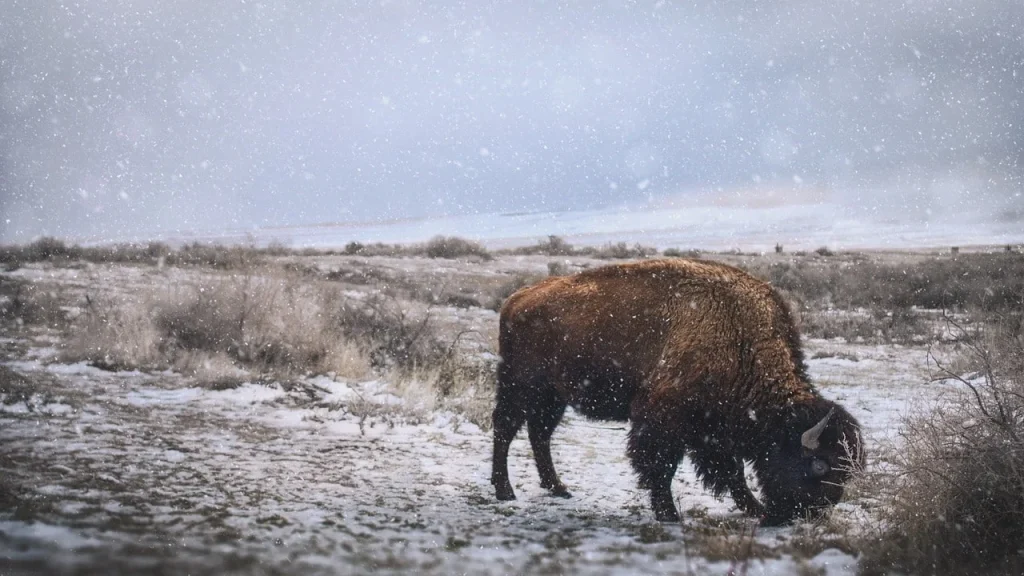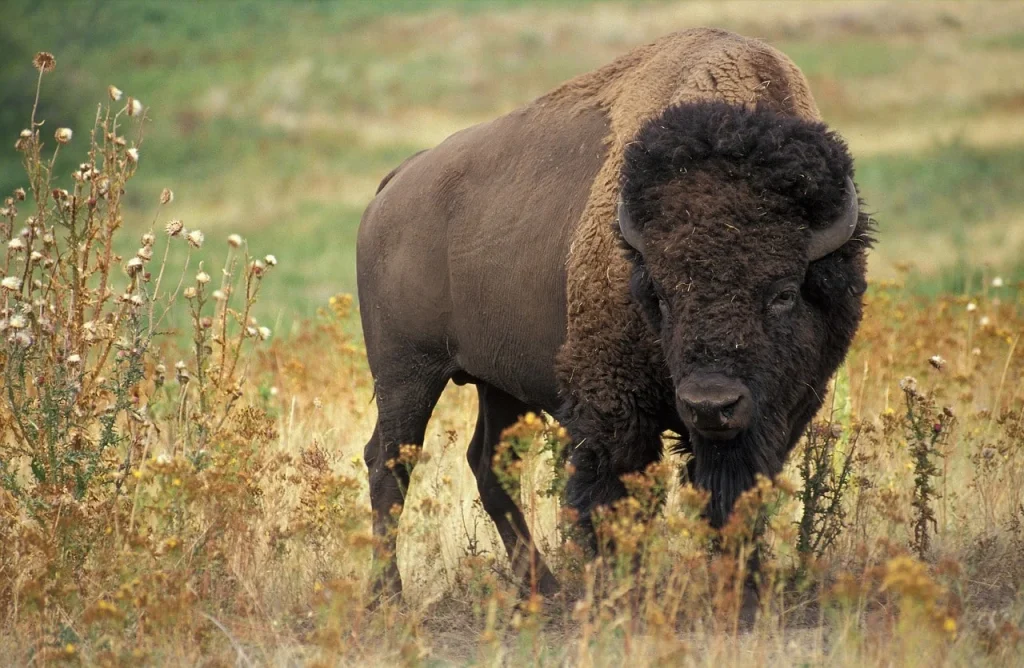Bison are the heavyweights of the animal kingdom, weighing up to 2,000 pounds. These majestic creatures roam the plains, captivating everyone who sees them. Their shaggy coats and massive heads make them look like something out of a prehistoric era.
Did you know that bison can run faster than a horse? Imagine that! You’ll discover many more surprising facts as we read some amazing facts about bison. Ready to learn more about these fascinating beasts? Let’s get started!
Buffalo is to the Plains Indians what the buffalo robe is to the Indian blanket.
Luther Standing Bear
Bison Facts
Before starting our journey into the world of bison, remember that a quiz awaits you at the bottom of this article. Test your knowledge and prove your expertise by reading each fact carefully.
- Their fur serves as insulation capable of withstanding extremely low temperatures.
- These creatures have a running speed that can outpace horses over short distances.
- American Indians relied on their tails as fashionable fly swatters and ceremonial whips.
- They partake in wallowing behavior to protect their skin from insects and shed fur.
- President Theodore Roosevelt established the American Bison Society in 1905 to prevent their extinction.
- When alarmed, they produce a snorting sound as a warning to the herd.
- Each animal consumes up to 24 pounds of vegetation daily.
- Their vision spans nearly 360 degrees, owing to eye placement on the sides of their head.
- Yellowstone National Park is the only place in the U.S. where bison have lived continuously since prehistoric times.
- Their gestation period is approximately 285 days, similar to humans.
- They display a unique behavior known as “horning,” where they rub their horns against objects to help shed their winter coat.
- Their lifespan in the wild can reach up to 20 years, but in captivity, it’s often longer.
- Their backbone has a distinctive hump which is actually a mass of muscle supporting their massive head.

- Yellowstone’s population of these animals has rebounded from just a few dozen in the early 20th century to thousands today.
- These creatures are known to help with grassland ecosystem maintenance by naturally fertilizing the soil.
- Historically, these animals were a central part of the Great Plains ecosystem, influencing the distribution of grasses.
- They use their massive heads like a plow in winter to clear snow in search of grasses beneath.
- Their skulls are so robust that they are used in traditional rituals by various Native American tribes.
- Despite their bulk, they are excellent swimmers, capable of crossing large rivers during migrations.
- Their footprints can help in creating microhabitats for other species by trapping moisture and seeds.
- Contrary to their bulky appearance, they can turn quickly and are agile in dodging predators.
- Their coat is so well insulated that snow can settle on it without melting from body heat.
- They can communicate with sounds that are inaudible to humans.
- They were once a cornerstone for the survival of the Plains Indians, providing food, shelter, and clothing.
- Calves are born with a reddish coat, which darkens as they mature.
- A single herd’s movements can significantly alter the landscape, creating a dynamic environment for other species.
- During mating season, males engage in intense displays and fights to win breeding rights.
- Their numbers once dwindled to the brink of extinction but have since recovered thanks to conservation efforts.

- Satellite technology has been employed to track and study their migratory patterns.
- Their digestive systems allow them to break down cellulose, enabling them to thrive on a grass-based diet.
- When threatened, a herd will form a circle, with calves in the middle, to protect them from predators.
- They have a keen sense of smell, which they use to locate food and detect danger.
- It’s possible for them to jump over obstacles nearly 6 feet high.
- Adult males are known as bulls, while females are referred to as cows, and together they form a social structure within the herd.
- Calves can walk and run within hours of birth, a crucial adaptation for herd survival.
- Their fur is used in various indigenous crafts, including traditional robes and blankets.
- These animals play a critical role in promoting biodiversity by maintaining open grasslands.
- Ranchers are increasingly raising them not only for conservation but also for their meat, which is leaner than beef.

- Their immune systems are particularly robust, making them resistant to many diseases that affect domestic cattle.
- Their meat has lower fat, cholesterol, and calorie content compared to beef, making it a healthier red meat option.
- Genetic studies have revealed distinct subspecies among North American populations, reflecting their adaptation to various environments.
- During the 19th century, these animals were hunted to near extinction with more than 50 million killed in less than a century.
- Reintroduction programs have successfully established populations in areas where they had been extirpated for over a century.
- They have a hierarchical social structure that helps in maintaining order within the herd.
- Despite their recovery, disease outbreaks, especially from bovine diseases, pose a significant threat to conservation efforts.
- During the rut, the grunts of bulls can be heard for miles, a sound characteristic of the breeding season.
- Modern genetic research has been employed to ensure the health and viability of populations through careful management of genetic diversity.
- They are considered a symbol of the American West and a flagship species for conservation in the United States.
- Their population recovery has become a success story often cited in discussions on wildlife conservation techniques.
- Unlike many ungulates, they can interbreed with domestic cattle, although this raises concerns about genetic purity among conservationists.
Bison Myths

Now that we’ve explored the facts, let’s clear up some common misconceptions. In the next section, we’ll separate myth from truth.
- Bison and Buffalo Are the Same
Though often used interchangeably, the terms “bison” and “buffalo” refer to different animals. Bison are native to North America and Europe, characterized by their humped shoulders and massive heads, whereas true buffalo (like the water buffalo and African buffalo) are found in Africa and Asia. - Bison Can’t Run Fast Because of Their Size
Despite their large size, they are surprisingly fast. Speeds of up to 35 miles per hour can be reached by them, enabling them to outrun humans easily and evade predators effectively. - Bison Are Domesticated Like Cows
Unlike cattle, they have not been fully domesticated. Efforts to domesticate them have been largely unsuccessful; they retain much of their wild behavior and are managed as semi-wild livestock in controlled environments. - Bison Populations Are No Longer at Risk
Although significant recovery has been made from near-extinction in the 19th century, bison populations are still managed carefully. It is considered that they are not out of danger, with habitat loss and genetic issues posing ongoing threats. - Bison Meat is High in Fat
their meat is often leaner than beef. It is preferred by health-conscious consumers because it is lower in fat and calories, yet high in protein and nutrients, making it a healthier alternative to traditional red meats.
Bison Quotes

Let’s continue to the quotes section. You can always share more in the comments and I will add them to the list.
The buffalo is a surprisingly difficult animal to hunt.
Meriwether Lewis
Meriwether Lewis notes the challenges faced by hunters pursuing bison.
Buffalo have this amazing ability to sense a storm coming and walk toward it.
Kris Brinker
Kris Brinker admires the resilience and instinctual behavior of bison.
In the American West, the buffalo were the true kings of the plains.
Dayton Duncan
Dayton Duncan highlights the dominance of bison in the Western landscape.
The buffalo represents the resilience and strength of Native American culture.
Winona LaDuke
Winona LaDuke connects the bison to the enduring spirit of Native American heritage.
When we see the buffalo, we see ourselves.
Floyd Red Crow Westerman
Floyd Red Crow Westerman reflects on the deep connection between Native Americans and bison.
Bison FAQ

As we move toward the close of our bison journey, the next section features frequently asked questions. Read carefully—these details will be essential for the quiz that follows.
- Are bison endangered?
They were once near extinction in the 19th century due to excessive hunting, but conservation efforts have successfully increased their numbers. Today, they are no longer considered endangered, but some subspecies are still under threat. - Can bison and cows breed?
Yes, bison and domestic cattle can interbreed. The offspring are known as “beefalo” and are fertile, combining traits of both parents. This hybridization is sometimes used to improve cattle herds but can pose a threat to the genetic integrity of wild bison populations. - Can bison swim?
They are surprisingly good swimmers. They can cross rivers and lakes when migrating or searching for food, using their natural buoyancy and strong legs to navigate waterways. - What do bison eat?
They are primarily grazers. Their diet consists mostly of grasses and sedges, though they will also eat herbs and shrubs depending on the availability of vegetation throughout the seasons. - How long do bison live?
In the wild, they typically live between 12 to 20 years. However, in captivity, where they are less susceptible to predators and diseases, they can live up to 25 years or more.
Bison Trivia

Welcome to the ultimate bison quiz! Better buff up your bison knowledge or you might find yourself being volunteered as the mascot for our next ‘Run with the Bison’ event!
Conclusion
As we’ve learned, bison are much more than just another animal in the wild; they are integral to the North American heritage and ecosystem. Their survival challenges and triumphs teach us valuable lessons about balance and coexistence in nature.
Let’s keep our minds open and continue to support efforts to preserve these magnificent beasts. Till next time, stay curious and explore more. Cheers.


